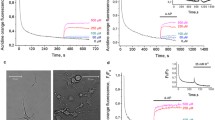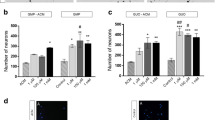Abstract
Phosphorylation of glial fibrillary acidic protein (GFAP) in slices from immature rats is stimulated by glutamate via a group II metabotropic glutamate receptor (mGluR II) and by absence of external Ca2+ in reactions that are not additive (Wofchuk and Rodnight, Neurochem. Int. 24:517–523, 1994). These observations suggested that glutamate, via an mGluR, inhibits Ca2+-entry through L-type Ca2+ channels and down-regulates a Ca2+-dependent dephosphorylation event coupled to GFAP. Because ryanodine receptors are present on internal Ca2+ stores and are associated with L-type Ca2+-channels, we investigated the possibility that the glutamatergic modulation of GFAP phosphorylation involves internal Ca2+ stores regulated by ryanodine receptors and whether the Ca2+ originating from these stores acts in a similar manner to external Ca2+. The results showed that the ryanodine receptor–agonists, caffeine and ryanodine and thapsigargin, all of which in appropriate doses increase cytoplasmic Ca2+, reversed the stimulation of GFAP phosphorylation given by 1S,3R-ACPD, an mGluR II agonist.
Similar content being viewed by others
references
Inagaki, M., Matsuoka, Y., Tsujimura, K., Ando, S., Tokui, T., Takahashi, T., and Inagaki, N. 1996. Dynamic property of intermediate filaments: Regulation by phosphorylation. Bioessays 18:481–487.
Wofchuk, S. T. and Rodnight, R. 1994. Glutamate stimulates the phosphorylation of glial fibrillary acidic protein in slices of immature rat hippocampus via a metabotropic receptor. Neurochem. Int. 24:517–523.
Kommers, T., Rodnight, R., Oppelt, D., Oliveira, D., and Wofchuk, S. 1999. The mGluR stimulating GFAP phosphorylation in immature hippocampal slices has some properties of a group II receptor. Neuroreport 10:2119–2123.
Wofchuk, S. T., and Rodnight, R. 1995. Age-dependent changes in the regulation by external calcium ions of the phosphorylation of glial fibrillary acidic protein in slices of rat hippocampus. Dev. Brain Res. 85:181–186.
Vinade, L., Goncalves, C. A., Wofchuk, S., Gottfried, C., and Rodnight, R. 1997. Evidence for a role for calcium ions in the dephosphorylation of glial fibrillary acidic protein (GFAP) in immature hippocampal slices and in astrocyte cultures from the rat. Dev. Brain Res. 104:11–17.
Leal, R. B., Goncalves, C. A., and Rodnight, R. 1997. Calcium-dependent phosphorylation of glial fibrillary acidic protein (GFAP) in the rat hippocampus: a comparison of the kinase/phosphatase balance in immature and mature slices using tryptic phosphopeptide mapping. Dev. Brain Res. 104:1–10.
Rodnight, R., Goncalves, C. A., Wofchuk, S. T., and Leal, R. 1997. Control of the phosphorylation of the astrocyte marker glial fibrillary acidic protein (GFAP) in the immature rat hippocampus by glutamate and calcium ions: possible key factor in astrocytic plasticity. Braz. J. Med. Biol. Res. 30:325–338.
Simpson, P. B., Holtzclaw, L. A., Langley, D. B., and Russell, J. T. 1998. Characterization of ryanodine receptors in oligodendrocytes, type 2 astrocytes, and O-2A progenitors. J. Neurosci. Res. 52:468–482.
Matyash, M., Matyash, V., Nolte, C., Sorrentino, V., and Kettenmann, H. 2002. Requirement of functional ryanodine receptor type 3 for astrocyte migration. FASEB J. 16:84–86.
Chavis, P., Fagni, L., Lansman, J. B., and Bockaert, J. 1996. Functional coupling between ryanodine receptors and L-type calcium channels in neurons. Nature 382:719–722.
Dulhunty, A. F., Haarmann, C. S., Green, D., Laver, D. R., Board, P. G., and Casarotto, M. G. 2002. Interactions between dihydropyridine receptors and ryanodine receptors in striated muscle. Prog. Biophys. Mol. Biol. 79:45–75.
Lee, B. S., Sessanna, S., Laychock, S. G., and Rubin, R. P. 2002. Expression and cellular localization of a modified type 1 ryanodine receptor and L-type channel proteins in non-muscle cells. J. Membr. Biol. 189:181–190.
Zucchi, R., and Ronca-Testoni, S. 1997. The sarcoplasmic reticulum Ca2+ channel/ryanodine receptor: modulation by endogenous effectors, drugs and disease states. Pharmacol. Rev. 49:1–51.
Fredholm, B. B. 1995. Astra Award Lecture. Adenosine, adenosine receptors and the actions of caffeine. Pharmacol. Toxicol. 76:93–101.
McPherson, P. S., Kim, Y. K., Valdivia, H., Knudson, C. M., Takekura, H., Franzini-Armstrong, C., Coronado, R., and Campbell, K. P. 1991. The brain ryanodine receptor: a caffeine-sensitive calcium release channel. Neuron 7:17–25.
Zhao, F., Li, P., Chen, S. R., Louis, C. F., and Fruen, B. R. 2001. Dantrolene inhibition of ryanodine receptor Ca2+ release channels. Molecular mechanism and isoform selectivity. J. Biol. Chem. 276:13810–13816.
Thastrup, O., Cullen, P. J., Drobak, B. K., Hanley, M. R., and Dawson, A. P. 1990. Thapsigargin, a tumor promoter, discharges intracellular Ca2+ stores by specific inhibition of the endoplasmic reticulum Ca2(+)-ATPase. Proc. Natl. Acad. Sci. USA. 87:2466–2470.
Simpson, P. B., and Russell, J. T. 1997. Role of sarcoplasmic/endoplasmic-reticulum Ca2+-ATPases in mediating Ca2+ waves and local Ca2+-release microdomains in cultured glia. Biochem. J. 325(Pt 1):239–247.
Laskey, A. D., Roth, B. J., Simpson, P. B., and Russell, J. T. 1998. Images of Ca2+ flux in astrocytes: evidence for spatially distinct sites of Ca2+ release and uptake. Cell Calcium 23:423–432.
Chavis, P., Shinozaki, H., Bockaert, J., and Fagni, L. 1994. The metabotropic glutamate receptor types 2/3 inhibit L-type calcium channels via a pertussis toxin-sensitive G-protein in cultured cerebellar granule cells. J. Neurosci. 14:7067–7076.
Pin, J. P., and Duvoisin, R. 1995. The metabotropic glutamate receptors: structure and functions. Neuropharmacology 34:1–26.
Gallo, V., and Russell, J. T. 1995. Excitatory amino acid receptors in glia: different subtypes for distinct functions? J Neurosci. Res. 42:1–8.
Dirksen, R. T. 2002. Bi-directional coupling between dihydropyridine receptors and ryanodine receptors. Front Biosci. 7:d659–d670.
Author information
Authors and Affiliations
Rights and permissions
About this article
Cite this article
Oppelt, D., Rodnight, R., Horn, J. et al. Role of Intracellular Calcium Stores on the Effect of Metabotropic Glutamate Receptors on Phosphorylation of Glial Fibrillary Acidic Protein in Hippocampal Slices from Immature Rats. Neurochem Res 29, 1541–1545 (2004). https://doi.org/10.1023/B:NERE.0000029567.68068.ab
Issue Date:
DOI: https://doi.org/10.1023/B:NERE.0000029567.68068.ab




